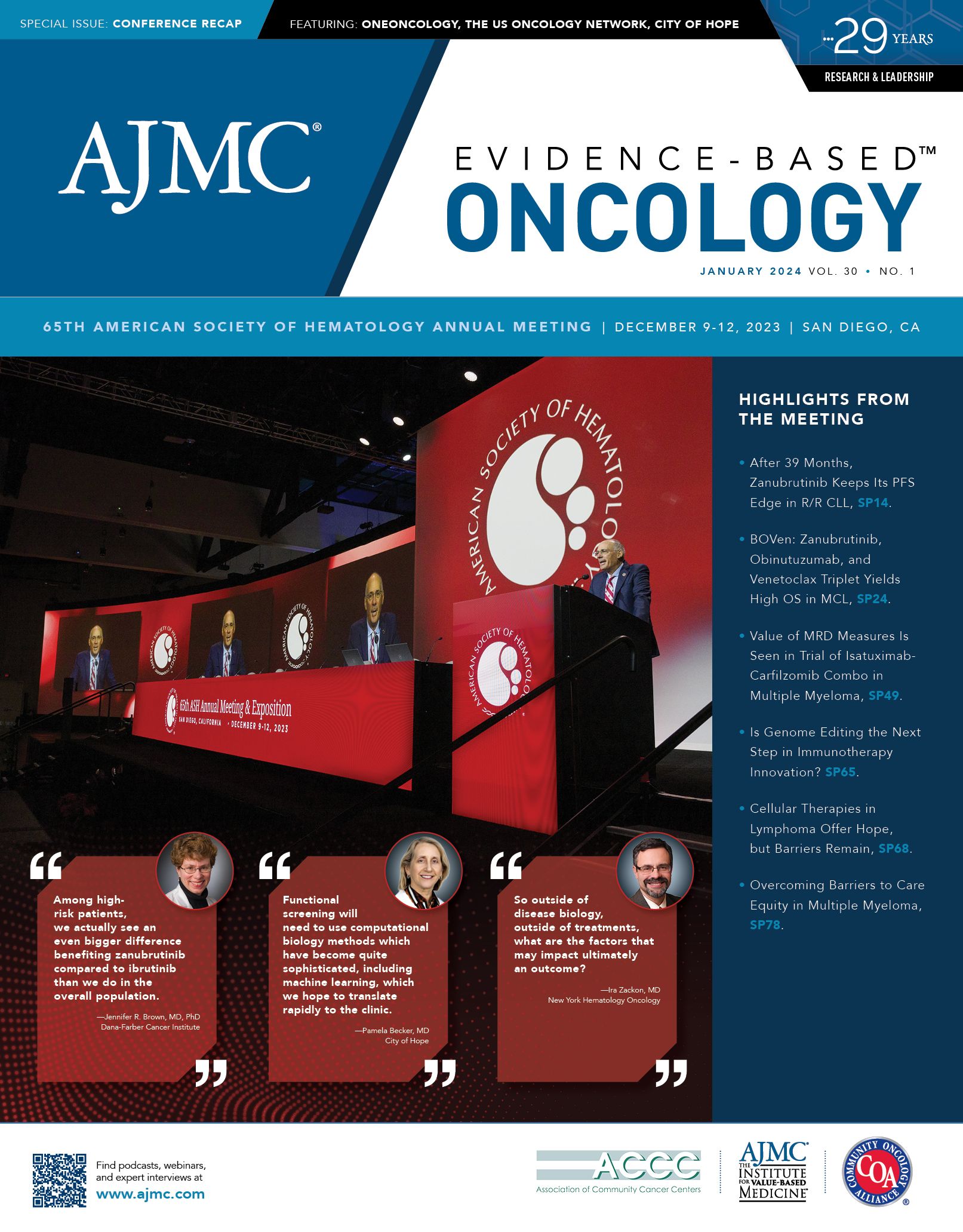- Center on Health Equity and Access
- Clinical
- Health Care Cost
- Health Care Delivery
- Insurance
- Policy
- Technology
- Value-Based Care
ASH Abstracts Showcase Effective Treatments for MM, CLL, FL
Abstracts from the 65th American Society of Hematology (ASH) Annual Meeting and Exposition provided new insight into multiple treatments for patients with multiple myeloma (MM), chronic lymphocytic leukemia (CLL), and follicular lymphoma (FL).
Abstracts presented at the 65th American Society of Hematology (ASH) Annual Meeting and Exposition provided crucial insights into the efficacy and safety of various medications and combination therapies for multiple myeloma (MM), chronic lymphocytic leukemia (CLL), and follicular lymphoma (FL).
Long-Term Effects of Liso-Cel in CLL
Tanya Siddiqi, MD | Image: City of Hope

A comprehensive study delved into the long-term effects of lisocabtagene maraleucel (liso-cel) in patients grappling with relapsed-refractory CLL/small lymphocytic lymphoma (R/R CLL/SLL). Presented by Tanya Siddiqi, MD, associate professor, Division of Lymphoma, Department of Hematology & Hematopoietic Cell Transplantation, City of Hope, the investigation showcased sustained response rates and continued safety up to month 24, consistent with earlier primary analysis findings. Importantly, this extended treatment period did not unveil any new safety concerns.1
Patients confronting relapsed-refractory CLL/SLL, intolerant to or progressing after Bruton tyrosine kinase inhibitor plus venetoclax treatment, currently face a therapeutic void, underscoring the urgent need for effective treatments. Liso-cel had previously demonstrated efficacy in large B-cell lymphoma and CLL/SLL, but its long-term outcomes remained uncertain.
Eligible patients received liso-cel at either a lower dose or a higher dose post chemotherapy, aiming for complete response or complete response with incomplete blood count recovery (CR/CRi) at the higher dose.
Of 137 patients undergoing leukapheresis, 118 received liso-cel. The efficacy-assessed group (n = 97) included 54 in the primary efficacy analysis set (PEAS) at the higher dose level (DL2), with a median age of 65 years.
As of the February 2023 cutoff, with a median follow-up of 23.5 months, PEAS at DL2 demonstrated a 20% CR/CRi rate, 44% overall response rate, and 64% undetectable minimal residual disease rates in blood, along with 60% in the marrow. The median response duration was 35.3 months, and the median progression-free survival (PFS) was 11.9 months.
Adverse events (AEs) were manageable, with 85% experiencing cytokine release syndrome (CRS), 45% neurological events. Forty-five patients (33%) died following to liso-cel infusion, primarily due to disease progression (27 patients); 6 deaths were due to AEs and 12 were due to other factors.
Comparing Daratumumab and Bortezomib Combinations in MM
Lucio Gordan, MD | Image: FCS

A meta-analysis looked into the use of daratumumab with lenalidomide and dexamethasone (DRd) vs bortezomib with lenalidomide and dexamethasone (VRd) as first-line therapy for transplant-ineligible (TIE), newly diagnosed multiple myeloma (NDMM) patients. The objective of the study, presented by Lucio N. Gordan, MD, president and managing physician, Florida Cancer Specialists & Research Institute, was to compare disease progression and mortality risk associated with each regimen.2
While DRd and VRd are recommended primary treatments, the lack of direct head-to-head studies complicates decision-making for health care providers. The study employed a comprehensive search strategy across databases and key congresses from January 2018 to June 2023, aligning with FDA and European Medicines Agency approvals for DRd in TIE NDMM.
Of 863 screened records, 4 (1 publication and 3 conference abstracts) from 3 unique studies were included, incorporating indirect treatment comparisons and a retrospective chart review for DRd- or VRd-treated patients. Across all studies, DRd showcased a significantly lower risk of disease progression and death than VRd. A meta-analysis of the 3 studies confirmed this, with DRd patients exhibiting a lower risk of progression/death (HR, 0.59; 95% CI, 0.42-0.82).
Phase 2 Data for Subcutaneous Mosunetuzumab in FL
Ian Flinn, MD, PhD | Image: Tennessee Oncology

Subcutaneous mosunetuzumab demonstrated safety and efficacy in patients with previously untreated, low-tumor burden FL, according to a presentation by Ian W. Flinn, MD, PhD, who is chief scientific officer of OneOncology and was recently named chief scientific officer of the Greco-Hainsworth Tennessee Oncology Centers for Research.
The bispecific antibody, approved for intravenous treatment in patients with R/R FL, exhibited effectiveness both intravenously and subcutaneously in the MorningSun phase 2 study (NCT05207670), encompassing various B-cell non-Hodgkin lymphomas, with initial data emanating from the United States.
During the study, enrolled patients were administered subcutaneous mosunetuzumab in 21-day cycles for up to 17 cycles (approximately 1 year). Those achieving a complete metabolic response at cycle 8 could discontinue treatment, with mandatory dexamethasone premedication in initial cycles. The primary end point focused on the PFS rate at 24 months.3
As of the March 6, 2023, data cutoff, 30 patients were enrolled, with a median age of 56 years and a median follow-up of 4.2 months. Among the 24 patients with post-baseline tumor assessments, 23 achieved an objective response, with 20 attaining a complete metabolic response, all observed by cycle 4.
Common adverse events included injection site reactions (53.3% of patients, all grade 1 or 2) and CRS (43.3%, mostly grade 1). Other frequent adverse events encompassed headache, nausea, fatigue, pyrexia, chills, and increased alanine aminotransferase. Grade 3 or greater adverse events were decreased neutrophil count. The most common serious adverse events reported were related to CRS, with no serious infections. Two patients experienced immune effector cell–associated neurotoxicity syndrome, resolving without mosunetuzumab discontinuation, and no fatalities were reported.
Tazemetostat Combo in R/R FL Shows Long Remissions in EZH2-Mutant Disease
Gilles Salles, MD, PhD | Image: MSK

An abstract that included co-authors from City of Hope and The US Oncology Network showed that tazemetostat (Tazverik, Epizyme), approved as an enhancer of zeste homolog 2 (EZH2) inhibitor, caused long remissions in patients with EZH2-mutant FL when combined with lenalidomide (Revlimid) and rituximab (Rituxan).4
Gilles Salles, MD, PhD, chief of the lymphoma service at Memorial Sloan Kettering Cancer Center, was the lead author on abstract with updated results from the phase 1b SYMPHONY-1 study (NCT04224493) that previously reported combining lenalidomide with rituximab. New data cover a median follow-up period of 22.5 months. Primary end points were safety and determination of a phase 3 dose. Secondary end points were pharmacokinetic (PK) parameters, with efficacy analysis on the intent-to-treat (ITT) population, including best overall response, PFS, and duration of response (DOR).
Co-authors included Tycel J. Phillips, MD, clinical associate professor, City of Hope, and David J. Andorsky, MD, of Rocky Mountain Cancer Centers and associate chair for hematology research, The US Oncology Network.
As of July 10, 2023, 44 patients had received combination, with at tazemetostat doses of 400 mg (6 patients), 600 (19 patients) and 800 mg (19 patients). Median age was 67 years; 31.8% had received more than 1 prior therapy, and 81.8% had wild-type EZH2 disease. Results showed the following:
- Median duration of treatment was 13.3 months for tazemetostat, 10.8 for lenalidomide, and 4.6 months for rituximab.
- In the 800 mg group, median relative dose intensity was 94.1% for tazemetostat, 92.9% for lenalidomide, and 100% for rituximab.
- No dose limiting toxicities or safety signals were seen.
- The 800 mg dose was selected for the phase 3 study, to be used with the combination.
Of the 44 patients, 42 were evaluable for efficacy: 23 had a CR, 17 had a partial response, and 2 had stable disease. ORR in the ITT group 90.9% (40 patients). ORR among those with wild-type EZH2 disease was 88.9% (32 of 36), and 100% (7 patients) among those with EZH2-mutant disease. Median PFS and median DOR were not reached. “PFS appeared to be dose dependent,” the authors said, with best responses seen in those taking 800 mg.
The authors said the 2-arm phase 3 study will examine the safety and efficacy of the combination in 500 patients with R/R FL who have received at least 1 prior therapy.
References
1. Siddiqi T, Maloney DG, Kenderian SS, et al. Lisocabtagene maraleucel (liso-cel) in R/R CLL/SLL: 24-month median follow-up of TRANSCEND CLL 004. Presented at: 65th American Society of Hematology Annual Meeting and Exposition; December 9-12, 2023; San Diego, CA. Abstract 330. https://ash.confex.com/ash/2023/webprogram/Paper179529.html
2. Gordan L, Medhekar R, Fu AZ, et al. Systematic literature review and meta-analysis of comparative clinical evidence investigating daratumumab, lenalidomide, and dexamethasone (DRd) versus bortezomib, lenalidomide, and dexamethasone (VRd) as first-line treatment for transplant-ineligible newly diagnosed multiple myeloma. Presented at: 65th American Society of Hematology Annual Meeting and Exposition; December 9-12, 2023; San Diego, CA. Abstract 1963. https://ash.confex.com/ash/2023/webprogram/Paper180829.html
3. Flinn IW, Budde ELE, Tun AM, et al. Subcutaneous mosunetuzumab is active and has a manageable safety profile in patients with previously untreated, low-tumor burden follicular lymphoma: initial results from the phase II MorningSun study. Presented at: 65th American Society of Hematology Annual Meeting and Exposition; December 9-12, 2023; San Diego, CA. Abstract 3029. https://ash.confex.com/ash/2023/webprogram/Paper177917.html
4. Salles G, Park SI, Phillips TJ, et al. Tazemetostat in combination with lenalidomide and rituximab in patients with relapsed/refractory follicular lymphoma: updated phase 1b results of SYMPHONY-1 with 22.5 months follow-up. Presented at: 65th American Society of Hematology Annual Meeting and Exposition; December 9-12, 2023; San Diego, CA. Abstract 3035. doi: 10.1182/blood-2023-179910

Dr Kathy Zackowski Discusses the Importance of Rehabilitation Research and Trials in MS
April 26th 2024Kathy Zackowski, PhD, National MS Society, expresses the inherent value of quality rehabilitation trials for broadening clinical understandings of multiple sclerosis (MS) and bettering patient outcomes.
Read More
Oncology Onward: A Conversation With Penn Medicine's Dr Justin Bekelman
December 19th 2023Justin Bekelman, MD, director of the Penn Center for Cancer Care Innovation, sat with our hosts Emeline Aviki, MD, MBA, and Stephen Schleicher, MD, MBA, for our final episode of 2023 to discuss the importance of collaboration between academic medicine and community oncology and testing innovative cancer care delivery in these settings.
Listen
Dr Lucio Gordan Discusses Updated Guidelines Addressing 1q Abnormalities in Multiple Myeloma
October 27th 2023Lucio Gordan, MD, president and managing physician of Florida Cancer Specialists & Research Institute, discusses recently updated clinical guidelines from the National Comprehensive Cancer Network (NCCN) in multiple myeloma, which specifically discuss disease staging and risk stratification and advise clinicians on how to address 1q abnormalities.
Listen
Award-Winning Poster Presentations From AMCP 2024
April 23rd 2024At the Academy of Managed Care Pharmacy (AMCP) 2024 annual meeting, multiple poster presentations concerned with health equity, data collection, glucagon-like peptide-1 agonists, and more were acknowledged for their originality, relevance, clarity, bias, and quality.
Read More
